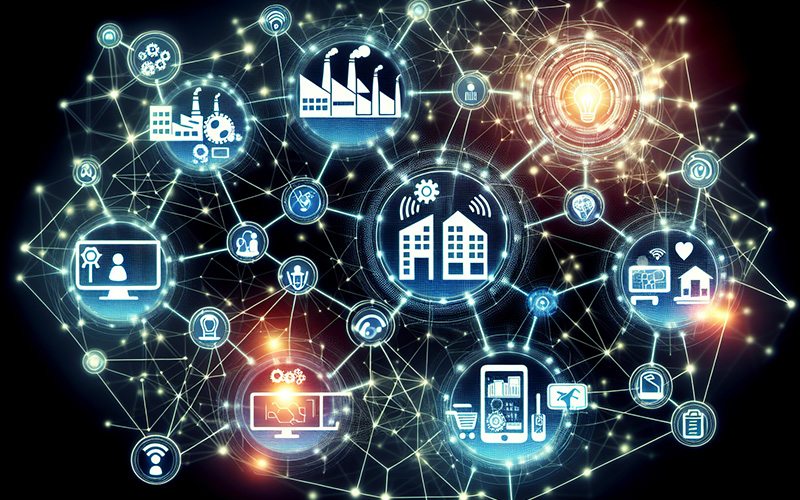What are the disruptive trends that will shape the digital agenda in 2024 and beyond? This article tackles this question head-on, providing you with a distilled view of the groundbreaking shifts in technology that are primed to transform industries, modify consumer behaviors, and revolutionize the way we interact with the digital world. Prepare to navigate the future; you’re about to discover the forces driving change and the strategies to manage the new digital frontier.
Key Takeaways
- Digital disruption is fundamentally reshaping industries through a culture of experimentation and demands strategic talent and technology utilization.
- Artificial intelligence and machine learning are pivotally transforming business processes, enabling automation and enhancing decision making, with significant advances in AI technology and widespread adoption across various industries.
- The Internet of Things (IoT) is revolutionizing operations, productivity, and customer experience in numerous sectors, contributing to the development of smart cities and advanced industrial logistics.
Digital disruption: the new normal
Digital disruption is no longer just trendy jargon; it has become an undeniable reality actively shaping the industrial landscape. The world is witnessing a seismic shift in expectations and behaviors in markets and industries, thanks to the transformative power of digital capabilities, channels, and assets. It’s like a ripple effect; the transformation disrupts the value proposition of existing goods and services, significantly impacting industry dynamics and competition.
Contrary to common belief, digital disruption extends beyond the mere incorporation of digital technology into business operations. It necessitates the adoption of a culture of experimentation and acceptance of failure, ultimately catalyzing profound changes in customer value delivery. The success of digital transformation efforts greatly hinge on strategic talent acquisition and effective technology usage, akin to a well-played game of chess.
The age of digital technologies
Welcome to the age of digital technologies where a striking 89% of companies are either adopting or planning to adopt a digital-first business strategy, thus making digital technologies an integral part of their business models. It’s a race, and to maintain their competitive edge, businesses are embracing digital transformation, which requires a shift in cultural paradigms and a continual reevaluation of existing business practices.
The specifics of digital transformation, however, are not one-size-fits-all. They vary with every company, with priorities often centered on enhancing customer experience, increasing operational agility, or improving profitability. It’s like a chessboard, where businesses employ offensive and defensive digital strategies to gain or protect their market share. This could mean forging digital platforms or bolstering operational efficiency with the help of digital solutions.
Adapting to change
Amid digital disruption, businesses have adapted to navigate the sea of change. Some key strategies they have employed include:
- Agile methodologies, which have become indispensable for managing changes in a volatile environment and maintaining a competitive edge
- Tailoring strategies to specific customer segments
- Leveraging digital distribution channels
- Employing technologies to automate tasks and reduce costs
These business growth strategies have helped businesses stay ahead in a rapidly changing landscape.
It’s a juggling act, and the successful companies are the ones that combine offensive and defensive strategies, continuously innovating while maintaining efficiency in their current operations.
AI and machine learning: transforming business processes
Venturing further into the maze of disruptive trends, artificial intelligence (AI) and machine learning stand out as pivotal game-changers. AI is not just a fancy buzzword; it’s a silent revolution transforming business processes. It’s streamlining operations by automating B2B sales campaigns and driving customer experience strategies. But that’s not all; AI in the workplace is fostering the creation of new roles, helping employees master new technologies and specializations more rapidly.
The cherry on the cake? Generative AI applications are empowering business users by providing access to vast sources of information, both internal and external.
Emerging AI technologies
The AI realm is teeming with innovation, with AI tools gaining accessibility through the provision of efficient foundation models that deliver robust performance while consuming fewer resources. Emerging multimodal AI technologies have upped the ante by processing and interpreting various types of data, thereby enhancing the versatility and performance of AI in multiple domains.
Businesses are now presented with the opportunity to develop custom AI solutions, thanks to open source models, contributing to a greater level of model development distinctiveness. However, the growing demand for AI brings its set of challenges, including:
- Advancements in AI-dedicated hardware
- Cloud services that can handle the computational requirements of AI
- Managing operational costs and resource limits
These challenges need to be addressed in order to effectively leverage AI technology.
On the bright side, virtual agents have advanced to a point where they can autonomously complete tasks and processes, transcending simple response actions. The integration of generative AI into large organizations is also on the rise, fueled by accessible artificial intelligence as demonstrated by Adobe’s launch of the AI model Firefly.
Widespread adoption
The adoption of AI isn’t merely a passing trend; it’s a global phenomenon creating ripples worldwide. The increasing accessibility of AI tools, the pressing need to automate processes and reduce costs, and the integration of AI into common business applications are accelerating this adoption.
Industries like financial services and telecommunications are leading the AI deployment race, with IT automation, digital labor, and customer care showing significant impacts from AI integration. On the global front, countries such as India, the UAE, Singapore, and China are showcasing leading active usage of AI, contrasting with lower adoption rates in nations like Spain, Australia, and France.
Enterprises are significantly increasing their investments in AI, focusing on R&D and workforce development as key areas, with predictions suggesting over 80% of enterprises will have utilized GenAI by 2026.
The internet of things (IoT): connecting the world
Envision a world where:
- your coffee maker understands your preferred coffee strength
- your electric vehicles modify their route in line with traffic updates
- your heating system self-regulates according to your preferred room temperature
It might sound like a scenario out of a science fiction novel, but it’s our reality today. Welcome to the era of the Internet of Things (IoT), an emerging technology revolution driving growth in various sectors, optimizing workflows, enhancing productivity, and improving customer experiences. As one of the most significant technology trends, IoT continues to shape our world.
IoT technology is helping businesses in the following ways:
- Cutting operational costs by optimizing workflows and providing real-time information for proactive maintenance, resulting in operational efficiency
- Enhancing workplace productivity and safety, as seen with Ford using sensor technology leading to a 70% reduction in assembly line injuries
- Exploiting IoT devices for sophisticated insights, as seen in retail stores using traffic pattern data to redesign store layouts and logistics companies to optimize schedules
The icing on the cake? IoT technology enhances consumer experiences by facilitating personalization and anticipating behavioral trends, improving customer loyalty, engagement, and customer satisfaction.
Smart cities and urban areas
Although the concept of smart cities might seem like a figment of a sci-fi movie, it’s a tangible reality in today’s world, all thanks to IoT. It’s a pivotal force in smart city development, enabling the creation of sustainable and efficient urban environments. In smart cities, IoT devices are pivotal for data-driven decision making and effective resource allocation, leading to enhanced urban living conditions.
Need proof? Look no further than Barcelona, Singapore, and Amsterdam, where IoT integration has improved traffic management, energy efficiency, and waste management. IoT contributes to smart cities by elevating public services, resource management, and resident safety and security.
Industrial IoT
The industrial sector isn’t far behind when it comes to adopting IoT and making technology investments. IoT devices are increasingly being adopted to enhance resource usage efficiency and streamline operations. For instance, IoT technology enables logistics companies to align delivery locations and schedules, resulting in more effective dispatching and routing.
The implementation of IoT in industrial logistics leads to improved utilization of vehicles and staff, optimizing the overall supply chain management.
5G and enhanced connectivity
Continuing our journey through the landscape of disruptive trends, we now shift our focus to 5G technology. It’s set to revolutionize data transfer speeds and reduce latency, which are critical for real-time applications and services. Faster data speeds and reduced latency enable businesses to develop innovative models and deliver enhanced customer experiences. But the influence of 5G extends beyond just speed and latency.
5G infrastructure is essential for the deployment and effective use of advanced technologies like AI, blockchain, and VR, propelling digital transformation. The acceleration of digital transformation through 5G technology will significantly impact various business sectors by providing the required support for emerging technologies.
Autonomous vehicles
5G technology is recognized as a crucial factor for the development of autonomous vehicles due to its capabilities in providing:
- Speed and connectivity necessary for real-time data processing and decision-making
- Faster and more reliable communication
- Enhanced traffic management and road safety by enabling better coordination between autonomous vehicles and infrastructure.
However, the successful integration of 5G with autonomous driving is challenged by the need for comprehensive 5G network coverage and the necessity of harmonizing the technology with the continuous advancement of autonomous vehicle systems. The widespread adoption of autonomous vehicles is dependent on public trust, which hinges on how effectively the industry can address concerns related to safety, privacy, and the reliability of autonomous technologies.
Remote healthcare
In the healthcare sector, 5G connectivity is making waves. It’s pivotal in enhancing remote healthcare services due to its high-speed and low-latency characteristics. The improved data transfer capabilities of 5G enable real-time patient monitoring, making it possible for healthcare providers to deliver immediate and effective care remotely.
Furthermore, 5G technology supports the deployment of advanced medical applications that require rapid and reliable communication, such as telesurgery and remote diagnostics.
Blockchain: reinventing trust and transparency
Advancing through the terrain of disruptive trends, it’s time to delve into the realm of blockchain technology. It’s enhancing the security of transactions through its decentralized, tamper-proof, and immutable nature, offering a new level of trust and transparency across various applications.
Financial services
In the financial services sector, blockchain is making waves. It’s being leveraged to:
- Create digital financial instruments
- Improve transactional processes in banking and lending
- Position major financial institutions for continued competitiveness
The implementation of distributed ledger technology is forecasted to result in significant cost savings in financial institutions, with cross-border settlement transactions potentially saving up to $27 billion by 2030.
Blockchain can significantly transform capital markets by simplifying processes, reducing transactional costs, shortening settlement times, and boosting asset liquidity through tokenization. It also promises improved efficiency in trade finance through digitized secure documentation and in insurance by enhancing claims processing and reducing fraud risk. The decentralization and immutability aspects of blockchain provide increased transparency in financial dealings, thereby enhancing trust between all parties engaged in financial transactions.
Supply chain management
In the realm of supply chain management, blockchain is a game-changer. It’s revolutionizing the field by offering new ways to enhance traceability, optimize inventory management, and streamline logistics. By using blockchain, companies can reduce incidents of fraud within supply chain management processes, ensuring more secure transactions.
Real-time tracking of goods using blockchain facilitates greater transparency across the supply chain and aids in the identification of inefficiencies. Moreover, smart contracts, enabled by blockchain, automate supply chain operations. This not only minimizes administrative burdens but also lowers the risk of disputes.
Generative AI: revolutionizing content creation
As our exploration of disruptive trends progresses, we now focus on generative AI. It’s a technological marvel that’s democratizing content creation in areas such as writing, music composition, and digital art. With the rapid evolution of generative AI applications such as ChatGPT and Stable Diffusion, a wide array of consumers now have access to tools that provide substantial creative capabilities.
Generative AI has catalyzed a transformation in the music sector by enabling the generation of original compositions from text or audio prompts, which holds potential for reshaping how music is created, disseminated, and experienced. Leveraging large datasets to identify patterns, generative AI systems in music can yield compositions that often bear a strong resemblance to those created by human artists.
Art and design
In the world of art and design, generative AI is making a splash. It’s being integrated to create novel and unique artwork that challenges traditional art creation methods. The emergence of generative AI has increased public interest and participation in digital art creation by making the process more accessible.
As the technology evolves, generative AI is expected to become a standard enhancement to established creative tools, as seen with Microsoft Office and Adobe Photoshop incorporating AI-driven features.
Music and entertainment
Generative AI is hitting the right note in the music industry. It’s gained recognition for its ability to:
- Compose music, presenting a potential to transform the music industry landscape
- Remix existing tracks
- Tailor personalized music recommendations
- Improve music production quality
Generative AI enhances the music experience by providing capabilities beyond composition.
The use of generative AI within the music industry is on the rise, emphasizing its significance with the development of new tools that can autonomously generate complete songs and instrumentals. These innovations pave the way for new forms of artistic collaborations, as musicians and producers leverage AI-generated materials to:
- Inspire and inform their own creative processes
- Experiment with new sounds and styles
- Enhance their compositions with unique and unexpected elements
- Speed up the songwriting and production process
The integration of AI in music creation opens up exciting possibilities for the future of the industry.
Cybersecurity: protecting the digital frontier
Just as the digital landscape continually evolves, its challenges also progress. Among these, cybersecurity emerges as a paramount concern in the current digital realm. The World Economic Forum’s Global Risks Report 2023 ranked cybersecurity as the 8th biggest risk in terms of impact, demonstrating its critical importance in the current digital landscape.
The integration of IoT in businesses brings with it considerable cybersecurity challenges, including the need for complex technology integrations and managing the evolving landscape of cyber threats.
Emerging threats
Venturing further into the cybersecurity sphere, we confront a myriad of burgeoning threats. The digital age has seen a rise in sophisticated cyberattacks using malware, phishing, and artificial intelligence, leading to risks for individuals, businesses, and governments. The frequency and sophistication of distributed denial of service (DDoS) attacks are increasing, urging enhanced cybersecurity measures to avert widespread disruption.
Cybersecurity becomes increasingly significant as:
- autonomous vehicles and 5G networks become more interconnected, necessitating advanced encryption and threat monitoring
- critical infrastructures like electrical grids and transportation systems are increasingly vulnerable to cyber-physical attacks
- cybersecurity threats are increasingly challenging to manage due to factors such as the global nature of the internet, interconnectedness between digital and physical systems, and complexities within cyber networks.
Best practices
While the cybersecurity landscape might seem bleak, there are best practices that can help mitigate these risks. Essential cybersecurity practices should include:
- Use of strong passwords
- Regular software updates
- Cautious interaction with suspicious links
- Enabling multi-factor authentication to protect against threats
Organizations are encouraged to develop and execute customized cybersecurity plans that cater specifically to their needs, recognizing the growing complexity of information technology in society and the unique challenges it presents.
Companies can combat cybersecurity threats by focusing on measures such as:
- Education and training of staff
- Adopting cutting-edge security technologies
- Conducting comprehensive security audits
- Hiring seasoned cybersecurity professionals
The future workforce: talent and skill development
Continuing our journey through key trends, including tech trends, our focus now shifts to the workforce of the future. Addressing the shortage of skilled cybersecurity professionals is crucial, with businesses investing in upskilling and reskilling strategies to retain talent and improve outcomes.
Upskilling and reskilling
In the face of an evolving job market, companies are focusing on enhancing existing skills and learning new ones. Upskilling refers to enhancing existing skills or acquiring new ones in line with changing job market demands, while reskilling involves learning entirely new skills often for transitioning into a new career field. A robust reskilling and upskilling strategy can be more cost-effective for companies than recruiting, hiring, and training new employees, with the cost of replacing an employee potentially as high as two times the employee’s annual salary.
Investing in employee skills is essential for retaining talent and improving business outcomes, with only 34% of workers today feeling supported by their organization’s skill development opportunities. The use of 5G in autonomous vehicles will likely lead to shifts in job market dynamics, necessitating new skills in fields such as network engineering and AI development.
Attracting top talent
In a competitive job market, attracting top talent is a challenge. Companies aiming to attract top talent develop compelling value propositions that include offering competitive compensation, access to modern technology stacks, and the opportunity to work on innovative projects, thereby outlining clear career paths for prospective employees. Effective leadership development programs that enhance power skills such as communication, critical thinking, and adaptability, in addition to hard skills, play a crucial role in attracting and retaining high-caliber talent.
To further entice and retain skilled professionals, organizations are adopting flexible employment models that support varied career trajectories, including options for midcareer breaks or industry shifts. The U.S. government’s endorsement of programs aimed at equipping Americans with AI-related skills and its efforts to attract global AI talent are essential in fostering an innovative ecosystem that is attractive to top-tier talent.
The role of government and regulation
As we approach the conclusion of our journey, it’s time to examine the role of government and regulation amidst these disruptive trends. Governments play a crucial role in governing the development and use of AI, ensuring safety, security, and trustworthiness. An executive order has been issued to advance and govern AI, focusing on safety, security, and establishing trustworthy systems aligned with eight guiding principles and priorities.
The AI Bill of Rights and an AI Risk Management Framework provide guidance for ensuring that AI technology complies with federal laws and promotes sound technical evaluations, oversight, and regulation. The legal and regulatory frameworks, such as those influenced by government AI policies, are critical factors that corporations must consider, influencing the pace and nature of AI adoption within the corporate sector.
Encouraging innovation
Government initiatives are not just about regulation; they also encourage innovation. Some examples of government initiatives in the semiconductor industry include:
- The U.S Department of State formed the International Technology Security and Innovation Fund backed by the CHIPS Act, allocating $500 million for developing secure telecommunications and ensuring semiconductor supply chain security.
- A $13.8 million cooperative agreement with Arizona State University exemplifies the U.S. government’s intent to invest in semiconductor technology education and workforce development.
- ITSI funding targets increasing global semiconductor capacity through new mining and refining ventures, fostering policy coordination internationally.
These initiatives demonstrate the government’s commitment to supporting and advancing the semiconductor industry, in collaboration with business and technology leaders.
Expansion plans to assemble, test, and package semiconductors in the Indo-Pacific and the Americas are strategically aimed at diversifying and securing the semiconductor supply chain.
Balancing progress and privacy
As technology advances, the balance between progress and privacy becomes a significant concern. Significant data breaches are becoming more common as companies fail to secure systems for managing third-party employees, raising concerns about privacy risks and the balance between technological progress and personal data protection.
As we wrap up our exploration of the top disruptive trends shaping the digital agenda in 2024 and beyond, it’s clear that we are at the dawn of a new era. From digital disruption, AI, IoT, 5G, blockchain to generative AI, the landscape is buzzing with innovation. But with innovation comes responsibility. It’s crucial to manage cybersecurity threats, develop skilled professionals, and balance progress with privacy. As we navigate these exciting times, let’s embrace the change that these technologies bring, and together, let’s shape a better, more connected world.
Frequently Asked Questions
What is digital disruption?
Digital disruption is the fundamental change in a market, process, or industry brought about by digital capabilities, channels, or assets.
How is AI transforming business processes?
AI is transforming business processes by streamlining operations, fostering new roles, and providing access to vast information sources for business users.
What role does IoT play in smart cities?
IoT plays a pivotal role in smart city development by enabling sustainable and efficient urban environments through data-driven decision-making and resource allocation.
How is blockchain impacting the financial sector?
Blockchain is revolutionizing the financial sector by enabling digital financial instruments, streamlining banking processes, and ensuring the competitiveness of major financial institutions.
What are some best practices for cybersecurity?
To ensure cybersecurity, it’s crucial to use strong passwords, update software regularly, be cautious with suspicious links, and enable multi-factor authentication. These practices help protect against potential threats and keep sensitive information secure.







0 Comments